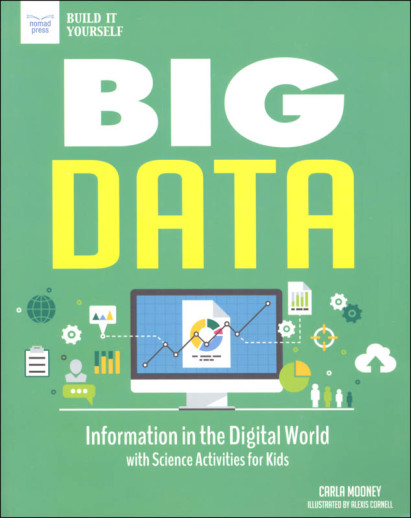We use cookies to make your experience better. To comply with the new e-Privacy directive, we need to ask for your consent to set the cookies. Learn more.
Big Data (Build it Yourself)
Have you ever wondered where data comes from, how we store it, and what it is used for? Explore the answers to these questions and more in this engaging book. Information is presented in an easy-to-read format, and hands-on projects are available after every chapter. QR codes allow you to scan primary sources to learn even more. ~ Gina
Have you watched videos online today? Did you post photographs on social media? Did you upload your English essay to Google docs?
All of these questions are questions about data. Data is information. It can be stored in books, magazines, on graph paper, in computers, and with many other methods. Most of the data that exists today is stored in computers, and the amount of data humans produce is doubling every year and half. That's why it's called big data!
In Big Data: Information in the Digital World with Science Activities for Kids, kids ages 10 to 15 explore the definition of data and learn about the relationship between data, computers, and people. They learn about the history of data, the transition from paper to computers, and the role that search engines such as Google play in handling data. Data management, data analytics, and the history of computers are all topics covered in this book on big numbers for kids.
Data is something computer scientists think about a lot. A computer's capacity to function and perform is directly related to how much data it can store. A computer that can't store much data won't be very popular. As more and more of our daily lives become connected to computers—schoolwork, watching movies on a laptop, paying for snacks with a debit card—computers are required to handle more and more data. New improvements in data storage mean that there are fewer limits on the amount of data businesses can store, but what does that mean for users? How does data management make our lives easier? Do we need all of this information or are we storing data we'll never use again simply because we can?
Throughout Big Data, STEAM investigations and experiments provide hands-on, problem-solving opportunities for students that incorporate various challenges and tools. Using readily available household items and recycled materials, each activity will take the reader through an inquiry-based, open-ended investigation that leaves plenty of room to explore individual creativity. With essential questions, fun facts, and links to online primary sources and videos, kids will mine the topic of big data and become better, more informed digital citizens of the world!
Have you ever thought about the history of robotics, how we collect big data, or how cities were developed? This series explores the answer to those questions and many more by presenting the history behind these topics and how it has evolved into our modern-day era. Chapters begin with an essential question to think about as students read the information presented in an engaging and understandable format. The timeline, pictures, and "Did You Know?" facts also keep the reader's attention. Vocabulary words are in bold with definitions in the sidebars. Several projects are included at the end of each chapter. All the books (not including Cities) are in color and include primary sources you can access by scanning QR codes with a smartphone or tablet. Read the whole series as a science unit, or pick and choose the books that pique your interest. Students can keep a journal of their activities in a separate notebook. ~ Gina
| Product Format: | Paperback |
|---|---|
| Brand: | Nomad Press |
| Grades: | 5-10 |
| ISBN: | 9781619306813 |
| Length in Inches: | 10 |
| Width in Inches: | 8 |
| Height in Inches: | 0.3125 |
| Weight in Pounds: | 0.7 |

